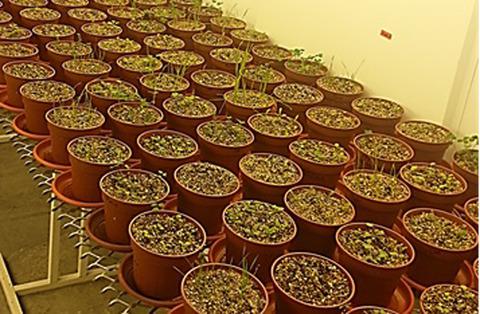当前位置:
X-MOL 学术
›
Funct. Ecol.
›
论文详情
Our official English website, www.x-mol.net, welcomes your
feedback! (Note: you will need to create a separate account there.)
Plant neighbours shape fungal assemblages associated with plant roots: A new understanding of niche-partitioning in plant communities
Functional Ecology ( IF 4.6 ) Pub Date : 2021-04-19 , DOI: 10.1111/1365-2435.13804 C. Mony 1 , V. Gaudu 1 , C. Ricono 1 , O. Jambon 1 , P. Vandenkoornhuyse 1
中文翻译:

植物邻居塑造与植物根系相关的真菌组合:对植物群落生态位划分的新理解
更新日期:2021-04-19
Functional Ecology ( IF 4.6 ) Pub Date : 2021-04-19 , DOI: 10.1111/1365-2435.13804 C. Mony 1 , V. Gaudu 1 , C. Ricono 1 , O. Jambon 1 , P. Vandenkoornhuyse 1
Affiliation

|
- Understanding the assembly rules of mycorrhizal fungi is crucial, given their tremendous importance in plant nutrition and health. Differentiation in plant-associated arbuscular mycorrhizal fungi (AMF) is likely driven by a host-preference effect. Coexisting plant species may then affect a focal plant microbiota through fungal dispersal among plants, and plant preferential recruitment of AMF. Both mechanisms are likely shaped by the plant's phylogenetic and functional strategies.
- We expected that (a) the structure of AMF assemblages associated with a focal plant depends on the identity of the neighbouring plant species; (b) this effect would be predicted by the phylogenetic and functional similarity between the focal and neighbouring plant species. These predictions were tested during the first stages of growth, by simulating the early development of plants within a community
- Using an experimental matrix-focal plant species design testing 15 neighbouring plants from five taxonomic families, we demonstrated that the neighbouring plants provided different species pools for the focal plant, Medicago truncatula, and influenced AMF communities associated with focal plant, especially in terms of richness but not relative evenness. Medicago truncatula grown with Brassicaceae or other Poaceae species displayed respectively no or low AMF richness compared to those grown with Rosaceae and Asteraceae species. These effects were weakly dependent on the phylogenetic distance from the neighbouring plant but were predicted by the functional proximity. AMF assemblages were enriched and bore more resemblance to the neighbouring plants when the neighbouring plants were functionally dissimilar from the focal one. Functional dissimilarity was only a significant predictor when based on traits characterizing the nutrient use and uptake strategy rather than on a more integrated growing strategy of the plant.
- Microbiota composition was shown to be dependent on the identity of the neighbouring plant, particularly on its functional below-ground niche. At the colonization stage, when the plant arrives in a community, plant mycobiota might be influenced by the spatial distribution of plants already present in the community. This work suggests a new view of the concept of niche partitioning in space for plants based on microorganism–plant interactions.
中文翻译:

植物邻居塑造与植物根系相关的真菌组合:对植物群落生态位划分的新理解
- 鉴于菌根真菌在植物营养和健康方面的重要性,了解菌根真菌的组装规则至关重要。植物相关丛枝菌根真菌 (AMF) 的分化可能是由宿主偏好效应驱动的。然后,共存的植物物种可能会通过植物间的真菌传播和植物优先募集 AMF 来影响焦点植物微生物群。这两种机制都可能由植物的系统发育和功能策略形成。
- 我们预计 (a) 与焦点植物相关的 AMF 组合的结构取决于相邻植物物种的身份;(b) 这种影响可以通过焦点植物物种和邻近植物物种之间的系统发育和功能相似性来预测。通过模拟社区内植物的早期发育,在生长的第一阶段测试了这些预测
- 使用实验性基质焦点植物物种设计测试来自五个分类科的 15 种相邻植物,我们证明相邻植物为焦点植物苜蓿提供了不同的物种库,并影响了与焦点植物相关的 AMF 群落,尤其是在丰富度方面但不是相对均匀度。与蔷薇科和菊科植物相比,用十字花科或其他禾本科植物栽培的蒺藜苜蓿分别显示没有或较低的 AMF 丰富度物种。这些影响微弱地依赖于与邻近植物的系统发育距离,但可以通过功能接近度进行预测。当相邻植物在功能上与焦点植物不同时,AMF 组合被丰富并且与相邻植物更相似。当基于表征养分利用和吸收策略的性状而不是基于植物更综合的生长策略时,功能差异只是一个重要的预测指标。
- 微生物群的组成取决于邻近植物的特性,特别是其功能性的地下生态位。在定植阶段,当植物到达群落时,植物菌群可能会受到群落中已有植物空间分布的影响。这项工作提出了一种基于微生物-植物相互作用的植物空间生态位划分概念的新观点。











































 京公网安备 11010802027423号
京公网安备 11010802027423号